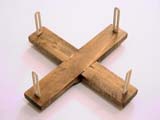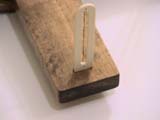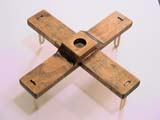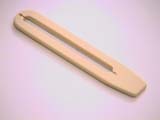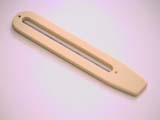Introduction

Here is a brief description of how I made an offset staff, 3 station staves, and a surveyor's cross.
An offset staff is used for measuring distances of 10 links or less, to a precision of 1/10th of a link. This is used along with a Gunter's chain to measure most distances in a survey.
Station staves are placed at various points in a survey to help sight to or from each point. It is useful to be able to plant these into the ground, and also to place certain instruments atop them.
A surveyor's cross is used to find a right angle between a line and an object. When using the cross, it is placed atop a staff.

Offset Staff
I made my offset staff from a 1 3/16 inch fir rod that I obtained from a local lumber yard. I used this diameter because, of those available, it was the largest that was comfortable to hold. After cutting the rod to the correct length, I painted it with a white enamel (this was available in the 18th century, though I don't know if it is what would have been used in this case). I then masked the areas I wanted to keep white and painted the rest black.
My painting is not perfect, but it is well within 1/100th of a link.
Station Staves
I made my staves out of 1 3/16 inch fir rod. After cutting them to length, I tapered one end using a wood plane. This makes them easier to plant in the ground. Ideally, I would put an iron ferrul or shoe on the end, but I have not done so.
I finished the staves with a stain and multiple coats of chinawood oil (also known as tung oil). Linseed oil would work as well. The oil was a commercial version that had been combined with spirits to make it faster drying.

Surveyor's Cross

One pair of sights is aligned with the line between the two stations by lining one station between the two sights and then verifying that the second station is visible along the two sights in the opposite direction. If the line of measurement runs straight between the two stations, when one station is lined up, so will the second station. Now, using the second pair of sights, the object to be measured is sighted. If it is lined up with the sights, then the staff with the cross is planted at the closest point along the line of measurement to the object (and thus a line measured from this point to the object will be at right angles to the line between the stations). If not, move the staff with the cross forward or back along the line between the stations until both stations line up in one pair of sights and the object of interest lines up in the other pair.
The chain is now used to measure between the location of the cross and the object of interest. If this distance is short, the offset staff can be used alone. In any case, the offset staff can be used to measure the distance to a tenth of a link. As always, the measurement is noted in the field book.
I made the body of my surveyor's cross from a piece of 1 x 3 maple. I made the cross 14 inches long, as this seemed long enough to make a straight sight, but not so long as to be cumbersome. I cut two pieces and dadoed them together. I cut another piece and cut a hole through it that was the same diameter as the station staves.
I cut four notches approximately 1/8 x 3/4 of an inch to hold my sights. This isn't the best way, as the sights can become misaligned, but it worked well enough.
I glued all the pieces together, then finished them with stain and chinawood oil.
For the sights, I used some synthetic ivory. I purchased a sheet of 1/8 inch thick micarta, which is a somewhat bland synthetic ivory made from phenolic-impregnated linen. It handles much like the natural substance, but is much cheaper (and not prohibited). Wood or brass would have worked as well.
I cut each of the sights in the same manner, with a 3/4 inch wide body, a 3 x 1/4 inch long slot in the center, and a total length of 4 1/4 inches. I drilled 1/16 inch holes to hole the sighting hair. I sanded the entire sight smooth. This was a lot of work, and would probably have been easier with power tools (the only power tool I used was a drill).
I used some black cotton thread for the sight hairs. Black hair (human or animal) would work better, but was not readily available. I put the thread through the holes, then anchored it in place with small pieces of wood (round toothpicks). I trimmed the wood and thread.

